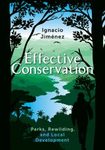By: David Rodríguez-Rodríguez(Author), Javier Martínez-Vega(Author), Trevor Sandwith(Foreword By)
128 pages, 51 colour & 4 b/w illustrations
![Effectiveness of Protected Areas in Conserving Biodiversity Effectiveness of Protected Areas in Conserving Biodiversity]()
Click to have a closer look
About this book
Contents
Customer reviews
Biography
Related titles
About this book
This book addresses the effectiveness of existing protected areas in conserving the diversity of genes, species and ecosystems on land and at sea. The book synthesizes the main biodiversity conservation outcomes of protected areas in the 2010-2019 decade, drawing on a systematic literature review of scientific publications and case studies from around the world demonstrating successes and failures. It provides region-specific results for land and sea ecosystems as well as for developed and developing countries. It also reviews current methodological approaches used to assess protected area effectiveness. The work is timely, since there is a growing concern about the global biodiversity crisis among researchers, government organizations and the general public, as demonstrated by the 2030 targets established by the UN Sustainable Development Goals for Life Below Water (SDG 14) and Life On land (SDG15). The book is written in an easy and enjoyable style using numerous pictures, tables and graphs to make the content more engaging and understandable. The main intended audiences of the book are academics, from post-graduate students to university lecturers, and senior researchers in the fields of biodiversity conservation, sustainable development and environmental policy, as well as protected area managers and practitioners.
Contents
Chapter 1. Human impact on the Biosphere: A biological genocide?
Chapter 2. Strategies to address the biodiversity crisis
Chapter 3. Protected areas
Chapter 4. Protected area effectiveness: What is it and how to assess it?
Chapter 5. A review of protected area effectiveness around the World: Methodological approach
Chapter 6. Results on protected area effectiveness in developed countries
Chapter 7. Results on protected area effectiveness in developing countries
Chapter 8. Main methodological approaches to assessing effectiveness around the globe
Chapter 9. Successes and failures: Lessons learned
Chapter 10. Conclusions: The future of protected areas and biodiversity
Customer Reviews
Biography
Dr David Rodríguez-Rodríguez is a Senior Biodiversity Conservation Researcher at the European Topic Centre of the University of Malaga, Spain. He holds a European-mention PhD degree in Conservation Biology (2012), 2 MSc degrees, 5 postgraduate degrees and 2 five-year BSc degrees. For the past 13 years, his professional and research line has mostly dealt with sustainability assessments of environmental policies and tools (chiefly protected areas) at different geographic scales: from individual protected areas to sub-national assessments, national assessments and global assessments. He is the author of 60 scientific or technical publications, including 40 indexed research articles, 6 books and 4 book chapters.
Dr Javier Martinez-Vega received his PhD in Geography from the Complutense University of Madrid (1989) and joined the Institute of Economics and Geography (CSIC) in 1990 as a Senior Researcher. Since then he has participated in research concerning the applications of Geographic Information Technologies (GIS and Remote Sensing), to the study of issues with territorial and environmental components (Land-use Land-cover changes, Protected Areas, Forest fires, Sustainability). He is the author of more than 87 scientific publications and 57 contributions to congresses.
By: David Rodríguez-Rodríguez(Author), Javier Martínez-Vega(Author), Trevor Sandwith(Foreword By)
128 pages, 51 colour & 4 b/w illustrations





































